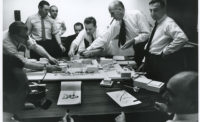 |
|
Still from "The Rise and Fall of Penn Station"
The Rise and Fall of Penn Station airs February 18 on PBS.
|
Based in part on Jill Jonnes’ 2008 book Conquering Gotham: Building Penn Station and Its Tunnels, the film is at its best when documenting the doomed transportation hub as “not only a place of journeys, but a place of memories,” in the words of architecture critic Paul Goldberger. MacLowry digs into the history of the Pennsylvania Railroad and Alexander Cassatt, the line’s president who hatched the idea of the terminal and commissioned McKim, Mead & White to design it. The filmmaker draws heavily on archival materials, like photos and contemporaneous news accounts, as well as talking heads, to track the transformation of Manhattan’s now-extinct Tenderloin neighborhood from a den of vice and corruption into a massive crater then into the Beaux Arts masterpiece that allowed travellers to enter New York like kings.
The documentation of the vanished Tenderloin alone makes Rise and Fall worth watching—as does the focus on Penn Station’s human story. MacLowry spends an admirable amount of time on the dangerous, heroic work of the sandhogs who blasted and braced the new train tunnels under the Hudson and East Rivers, most of the time under constant threat of major injury or death. He also interviews people with personal connections to the terminal.
Where the film begins to suffer, though, is in the architectural history. MacLowry packs a lot in, from the influence of Paris’ Gare d’Orsay station on Charles McKim’s Penn Station plan to his relationship with Cassatt and their goal to privately build a grand space for public use. And, of course, there’s the destruction narrative and its legacy as a flashpoint in the modern preservation movement. But in the film’s 53 minutes there is hardly enough time to do any of this justice.
The demolition of Penn Station, for example, is one of the all-time tragedies in American building history, and a lot of people know the basic plot: Penn Station is sold by the Pennsylvania Railroad to the group that tears it down to make way for Madison Square Garden, burying a the new railroad terminal in a subterranean warren. But it’s also so dense that it could fill an hour-long film on its own. Yet here, MacLowry gives it little more than a furtive glance. When we reach Penn Station’s decline—46 minutes into the film—we’re given an ultra-condensed version of what led to the decision to tear it down before the narrator says, “A few people protested, but to no avail.” For the record: More than a few people protested, and they certainly demand more than eight words of attention. But why linger on protesters when you can get right to the destruction porn?
The Rise and Fall of Penn Station gets a lot right. But it zips by—or ignores altogether—far too many aspects of the terminal’s story, not only its demise, but also plans to resurrect some of its grandeur by converting the Farley Post Office into a new station or even razing Madison Square Garden in favor of a new structure. Like so much in New York, Penn Station’s story is ongoing. Just not in this documentary. With less than an hour to work with, hard choices surely had to be made. Yet it’s difficult to shake the feeling that this is an outline or proof-of-concept for a larger documentary.






Post a comment to this article
Report Abusive Comment